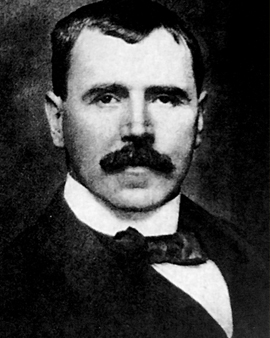John Lavery was an Irish painter who was internationally renowned in his day. Lavery's childhood and the way to art was tragic. He was born in Belfast, where his family first planned to open an inn. But the business remained unsuccessful. When Lavery was 3 years old, his father decided to take a ship to America in the hope of giving his family a better life. However, he never arrived in New York because the ship capsized. Shortly afterwards, Lavery's mother died and the three children became orphans. The siblings were separated and John was placed with an uncle in rural Northern Ireland. However, for unknown reasons, John was sent to Scotland at the age of 10 to live with a wealthy cousin of his aunt. He ran away from there at the age of 15 and lived on the streets of Glasgow for a while until he was finally sent back to Moira. There he lived for another 2 years. During this time he became interested in painting and began to learn how to copy copperplate engravings.
When Lavery returned to Glasgow, he was able to get an apprenticeship as a photographer's retoucher at the Glasgow Herald. The good pay, which was good by then standards, enabled him to enrol at one of the best art academies in Glasgow. This was the beginning of his artistic training, which would later take him to Paris and London, among other places. Lavery studied in Glasgow under Joseph Crawhall II. His breakthrough as an artist came in 1888, when he was commissioned to photograph Queen Victoria's state visit. From then on he was a much sought-after portrait and society painter. Shortly afterwards he moved to London, where he became friends with James Abbott McNeill Whistler. Whistler exerted a great influence on Lavery's work.
Lavery was married twice. His first wife Kathleen MacDermott died of tuberculosis after two years of marriage. The couple had a daughter. About 8 years later Lavery married again. His second wife Hazel Lavery, born Martyn, came from a wealthy Irish-American family. She brought her daughter Alice, from a previous relationship, into the marriage. The beautiful Hazel posed for her husband in over 400 paintings. Even when Lavery was commissioned by the Irish government to design a motif for a banknote, Hazel posed for him. The Lavery couple moved in the highest circles in London and received many celebrities from politics and art. Lavery was knighted in 1918 and later accepted into the Royal Academy. He was the only one who was appointed honorary citizen of both Dublin and Belfast. During the Second World War, Lavery, who was now widowed, sought refuge with his stepdaughter and her husband in Northern Ireland. He remained steadfastly committed to art there and was already planning his next painting on the day of his death.
×





.jpg)
.jpg)
.jpg)
.jpg)
.jpg)
.jpg)
.jpg)
.jpg)
.jpg)
.jpg)
.jpg)
.jpg)
_-_(MeisterDrucke-1115701).jpg)
_-_(MeisterDrucke-1115701).jpg)
.jpg)
.jpg)
.jpg)
.jpg)
.jpg)
.jpg)
.jpg)
.jpg)
.jpg)
.jpg)
.jpg)
.jpg)
_-_(MeisterDrucke-1645759).jpg)
_-_(MeisterDrucke-1645759).jpg)
.jpg)
.jpg)
_-_(MeisterDrucke-892604).jpg)
_-_(MeisterDrucke-892604).jpg)
.jpg)
.jpg)
.jpg)
.jpg)
.jpg)
.jpg)
.jpg)
.jpg)
.jpg)
.jpg)
.jpg)
.jpg)
.jpg)
.jpg)
_-_(MeisterDrucke-1104493).jpg)
_-_(MeisterDrucke-1104493).jpg)
_-_(MeisterDrucke-1315473).jpg)
_-_(MeisterDrucke-1315473).jpg)
.jpg)
.jpg)
.jpg)
.jpg)
_-_(MeisterDrucke-1116846).jpg)
_-_(MeisterDrucke-1116846).jpg)
.jpg)
.jpg)
.jpg)
.jpg)
.jpg)
.jpg)
.jpg)
.jpg)
.jpg)
.jpg)
.jpg)
.jpg)
.jpg)
.jpg)
.jpg)
.jpg)
.jpg)
.jpg)
.jpg)
.jpg)
.jpg)
.jpg)
.jpg)
.jpg)
.jpg)
.jpg)
.jpg)
.jpg)
.jpg)
.jpg)
_-_(MeisterDrucke-1132734).jpg)
_-_(MeisterDrucke-1132734).jpg)
.jpg)
.jpg)
.jpg)
.jpg)
.jpg)
.jpg)
.jpg)
.jpg)
.jpg)
.jpg)
.jpg)
.jpg)
.jpg)
.jpg)
.jpg)
.jpg)
.jpg)
.jpg)
.jpg)
.jpg)
.jpg)
.jpg)
.jpg)
.jpg)
_-_(MeisterDrucke-1133481).jpg)
_-_(MeisterDrucke-1133481).jpg)
.jpg)
.jpg)
.jpg)
.jpg)
.jpg)
.jpg)
.jpg)
.jpg)
.jpg)
.jpg)
.jpg)
.jpg)
.jpg)
.jpg)
.jpg)
.jpg)
.jpg)
.jpg)
.jpg)
.jpg)
.jpg)
.jpg)
.jpg)
.jpg)
.jpg)
.jpg)
.jpg)
.jpg)
_-_(MeisterDrucke-1122104).jpg)
_-_(MeisterDrucke-1122104).jpg)
.jpg)
.jpg)
_-_(MeisterDrucke-892862).jpg)
_-_(MeisterDrucke-892862).jpg)
.jpg)
.jpg)
.jpg)
.jpg)
.jpg)
.jpg)
_-_(MeisterDrucke-911565).jpg)
_-_(MeisterDrucke-911565).jpg)
 from British Artists at the Front continuation of The Western Front 1918 - (MeisterDrucke-161129).jpg)
 from British Artists at the Front continuation of The Western Front 1918 - (MeisterDrucke-161129).jpg)
.jpg)
.jpg)
.jpg)
.jpg)
.jpg)
.jpg)
.jpg)
.jpg)
.jpg)
.jpg)
.jpg)
.jpg)
.jpg)
.jpg)
_-_(MeisterDrucke-890512).jpg)
_-_(MeisterDrucke-890512).jpg)
_-_(MeisterDrucke-1130211).jpg)
_-_(MeisterDrucke-1130211).jpg)
.jpg)
.jpg)
_c1914_(oil_on_canvas)_-_(MeisterDrucke-907978).jpg)
_c1914_(oil_on_canvas)_-_(MeisterDrucke-907978).jpg)
.jpg)
.jpg)
_-_(MeisterDrucke-1497526).jpg)
_-_(MeisterDrucke-1497526).jpg)
.jpg)
.jpg)
.jpg)
.jpg)
.jpg)
.jpg)
.jpg)
.jpg)
.jpg)
.jpg)
.jpg)
.jpg)
.jpg)
.jpg)
_-_(MeisterDrucke-1119002).jpg)
_-_(MeisterDrucke-1119002).jpg)






